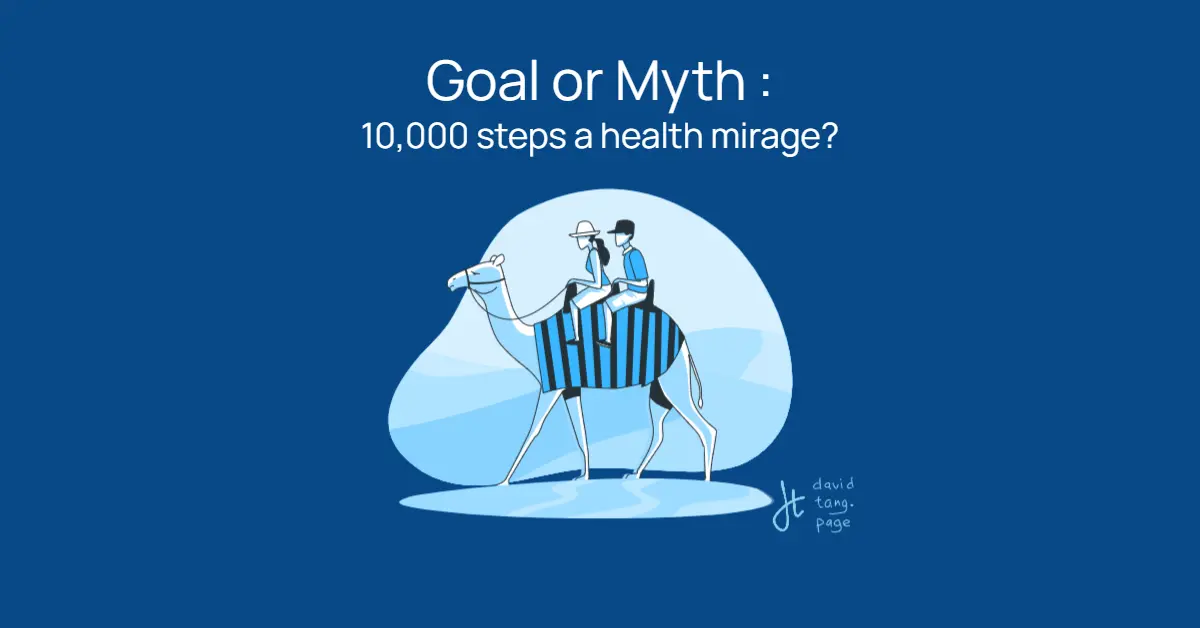Goal or Myth: 10,000 steps a day?
Is the 10,000 steps a day a health fad? What do scientists think about the matter? Let's look at this together in this article today and get my personal opinion.

An often touted 'number' on fitness trackers - the 10,000 steps daily target. Get a celebration of confetti upon hitting this. A friendly buzz on your wrist, and that hit of dopamine for achieving a goal for the day.
I have often wondered about this. Is it more of a marketing ploy, or is there actual science behind this? Let's get into it today.
Origin story
Come let me bring you back to the beginning, where the legends originated from.
The Manpo-kei is one of the first references to the idea. Starting in Japan about the time of the 1964 Japan Olympics, a large public adoption of carrying a portable step-measuring device happened.
This is the breakdown of the meaning and the actual Japanese characters.
歩 (Bu) - steps
I also found an interesting advert that even features the actual device used. It seems to be tailored toward everyday use and is family-friendly.

What does the current evidence say?
A quick Google search pulls up articles from several reputable sources. I think I can trust Harvard to get it right. But look closely at what follows, the next few headlines seem to disagree. So who is right here?

A large study in the UK, called the BioBank involving over half a million participants, shows some data that could answer this question. del Pozo and team have crunched this data in 2022 and here's what they found [1].
This how they did it: by measuring the number of steps taken on an average week and then checking up on the participants 5-8 years later.
It seems that the risk of death from all causes is reduced by over 50% with 10,000 steps. And there is an increasing amount of protection going from nought to about 10,000. Additional steps above this number seem to have diminishing returns.
There are a couple more interesting side notes from their results:
- A continued and additional overall protection from cancer death with an increased number of steps from 10,000 to 25,000 (~15% additional protection).
- They tracked several types of step-taking - including total overall daily steps, incidental steps, and if the steps were taken within short clusters (termed by the researchers as 'purposeful steps'). The beneficiary effects are seen in all types of steps recorded.

Flaws: Reading between the lines
Measuring the steps alone is a simple way of helping us get clarity and some ideas of its benefits. As with anything involving human beings - we are bound to run into different interpretations. People are more complex, intricate, and complicated than we think.
That means it is often a fool's errand to reduce or oversimplify a health recommendation to just one thing. I mean, just look at the huge amount of variability and heterogeneity among the people around you (ie. different choices of shopping cart food at the local store).
Now to expand on that, throw in differences in cultures, jobs, family structure, dietary habits, finances, stress levels, etc.
No study will confidently be able to tease all of these apart from one another with a certain confidence. The study above does acknowledge that it's participants are not reflective of all types of people in the UK. They are in fact, mostly comprised of the elderly (average age of 60 years), who are relatively educated and well-off socially.
We'll have to take the scientific evidence for what it is, yet not get totally sucked into it. So here's my take on the issue below:
David's personal takeaways
Perhaps we are reading too much into the exact amount. Wanting to be precise on something that does not really need a value. After all, we don't measure how long one is out in the sun every day. Some sunshine is better than none, that's for sure. And we all intuitively know that.
Too much sunshine, does lead to skin cancer. So, it is really a balance as well that we want.
I hate to say it, though, at the end of the day, it is really a personalized factor. I would not get too caught up with hitting an abstract number while ignoring other areas of health such as sleep and diet.
If keeping track helps nudge one from a completely sedentary lifestyle, I would totally agree that it is a good thing. Again, some is better than none. Too much, obsessing over it can be unhelpful. So, it's just a nice balance to stay active overall.
Mix and match different types of activities/sports and be consistently active, I think that would be the best way to go.
References
- del Pozo Cruz B, Ahmadi MN, Lee I, Stamatakis E. Prospective Associations of Daily Step Counts and Intensity With Cancer and Cardiovascular Disease Incidence and Mortality and All-Cause Mortality. JAMA Intern Med. 2022;182(11):1139–1148. doi:10.1001/jamainternmed.2022.4000
